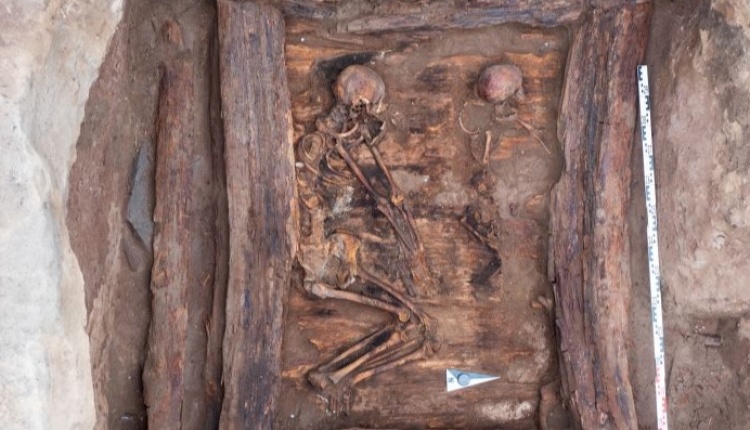Golden Pectoral and Bronze Mirror- Discoveries of Archaeologists in a Siberian Barrow
The archaeological site Chinge-Tey is located in the Touran-Uyuk valley in northern Tuva, a republic in the Asian part of the Russian Federation. It is called the ‘Siberian Valley of the Kings’ because of the many large barrows with rich equipment, dating back more than 2.5 thousand years. Some of them are referred to as princely barrows.
Last year, Polish archaeologists from the Jagiellonian University in Kraków discovered two intriguing graves. The first of them was in the central part of a destroyed, almost completely flattened barrow with a diameter of approx. 25 m. Almost invisible to the naked eye, It was detected by aerial laser scanning.
The wooden burial chamber, built in the framework of solid beams, contained the remains of two bodies. The chamber itself was covered with three layers of beams. The floor was covered with planks. According to the researchers, the deceased were a woman who died at the age of approx. 50 years old and a 2-3 years old child.

Next to the remains of the woman, the researchers found gold ornaments, an iron knife, a bronze mirror and a very well preserved wooden comb decorated with engraved ornament.
‘A particularly interesting artefact was a golden pectoral ornament, a decoration hung at the neck in the shape of a sickle or crescent’, says the head of the Polish part of the expedition, Dr Łukasz Oleszczak from the Jagiellonian University in Kraków. He emphasises that objects of this type, known from mounds in southern Siberia, have so far been found almost exclusively in the graves of men.
‘They were considered symbols of belonging to a social group, caste, perhaps warriors – in any case, men. Its presence in the grave of a woman is a very interesting deviation from this custom. This certainly confirms the unique role of the deceased in the community of the +Valley of the Kings+’, the archaeologist says.
He points out that the woman was buried in the central part of the tomb located in the immediate vicinity of the great barrow that, according to the researchers, belongs to a nomad prince. ‘It seems that, like the others buried in this barrow, she belonged to the prince’s entourage’, says Oleszczak.
He mentions the condition of the grave goods made from organic material. The researchers from the Polish-Russian expedition had previously found arrow shafts, an ice axe handle, a piece of a quiver. The woman’s grave contained a wooden comb connected with a leather loop to a mirror made of bronze. This set of cosmetic items was placed in the grave in a leather pouch.
The second grave discovered in the last season of excavation was located outside the ditch surrounding the barrow. It was the skeleton of a teenage child, placed in a small pit surrounded by stones. It did not contain any equipment.
‘Graves of children on the perimeter or just outside the ditch surrounding the barrow are a typical part of the funeral rites of this early Scythian culture’, adds Dr. Oleszczak.
The archaeologists also found evidence that a treasure of objects made of bronze was most likely deposited around the perimeter of the barrow at some point. Evidence of this is the discovery of tens of horse tack parts, a bronze ice axe, as well as an ornament in the form of a goat.
They were located with a metal detector. According to Dr. Oleszczak, the treasure was scattered by deep ploughing in the 20th century, when a kolkhoz operated near the cemetery.
In 2021, Polish archaeologists continued their research within the barrow they started to excavate two years earlier. Back then, they found two burials – a central, robbed one, and an intact side grave that contained the body of a young warrior, richly equipped with weapons, a knife, a whetstone and gold ornaments. This is one of the 10 tombs located in a row on the north-south axis in the western part of the cemetery.
According to the researchers, the graves come from the 6th century BCE, when the peoples of Scythian origin lived in these areas. According to the experts, it was the Aldy-Bel culture. In the early Scythian period, the Touran-Uyuk valley was one of the most important ritual centres of the Scythian and Siberian worlds. It was from there, from the mountains of southern Siberia, that the people originated who dominated the steppes of Eastern Europe.

The Scythians were known for being warlike. Their achievements have been described, among others, by the famous Greek historian Herodotus.
The research was supported by a grant awarded by the Polish National Science Centre. The excavations were carried out in cooperation with scientists from the State Hermitage Museum in St. Petersburg, under the supervision of Konstantina V. Chugunova.





